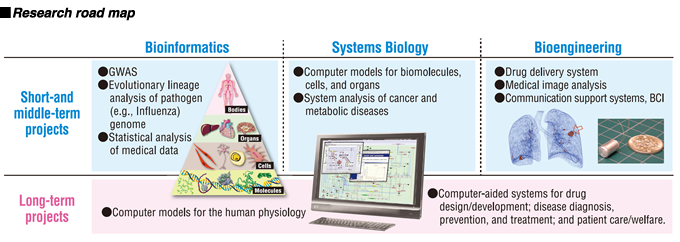Bioinformatics Research
Using of the top-down approach (statistical or data-driven analysis) for genome, genomic, and medical data collection could offer novel methods for disease diagnosis, prevention, and treatment, and helps predicting the efficacy of drug administration in treating diseases.
The Genome-Wide Association Study (GWAS) indicates the manner in which single-nucleotide polymorphisms (SNPs) are related to specific diseases. SNPs are the basic form of variation in the genome, and are responsible for genetic effects that produce susceptibility to the diseases. Evolutionary lineage analysis is able to predict the influenza virus sequence that will be prevalent during the next year. Hospital infection and infectious disease propagation mechanisms have been investigated to discover and refine effective prevention methods. These studies contribute to advances in public health and sanitation.
Systems Biology Research
The bottom-up approach, or model-driven study, is used to develop the Virtual Physiological Human model. The computer model integrates multiscale objectives (molecules, cells, organs, and bodies); multisystems (e.g., nerve, digestion, and immune systems); and multiphysics (mechanics, chemistry, and electromagnetics) and would be an intelligence infrastructure for studying disease diagnosis, prevention, and treatment; drug design/development; and a variety of care/welfare systems.
The simulation technology can predict the manner in which ligands or drugs will interact with cell surface receptors. The mechanisms by which cancer cells cause metabolic and physiological changes will be analyzed to aid in the development of a new multidrug regimen for cancer, and a three-dimensional mathematical model will be constructed to simulate environmental or genetic perturbations that may alter the biochemical and physiological status of cells, tissues, and organs.
Bioengineering Research
We match our technological “seeds” to medical “needs” to solve a variety of problems. The mechanisms of mass transfer in blood vessels and bowels have been analyzed to develop mechanical devises necessary for a drug delivery system using Micro Electro Mechanical Systems (MEMS). A computer-aided diagnosis system was also developed to analyze the medical images provided by Computed Tomography (CT), Magnetic Resonance Imaging system (MRI), Positron Emission Tomography (PET), and echograms. In addition, by applying image-processing technology to lip-reading, a vision-based communication support system has been developed. The Brain–Computer Interface (BCI) is a direct communication pathway between the brain and an external device. The BCI system is potentially able to convert brainwaves (the input signal) into control signals for a computer using modern machine-learning methods.
International Education and Research Exchange
We are expanding the Asian Bioinformatics Research and Education Network (ABREN) in order to promote the communication between researchers and students through the World Wide Web. ABREN holds multimedia online training workshops on bioinformatics and systems biology, and supports the exchange of information among its participants. We hold international conferences to inform researchers worldwide of our achievements, and to facilitate interdisciplinary exchanges among biologists, medical doctors, informaticians, and engineering scientists. Finally, we conduct joint research with Asian students and researchers to promote research exchange.

